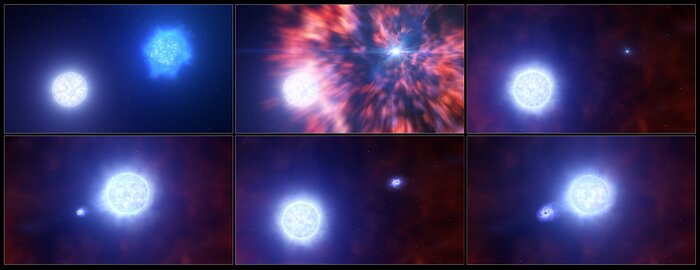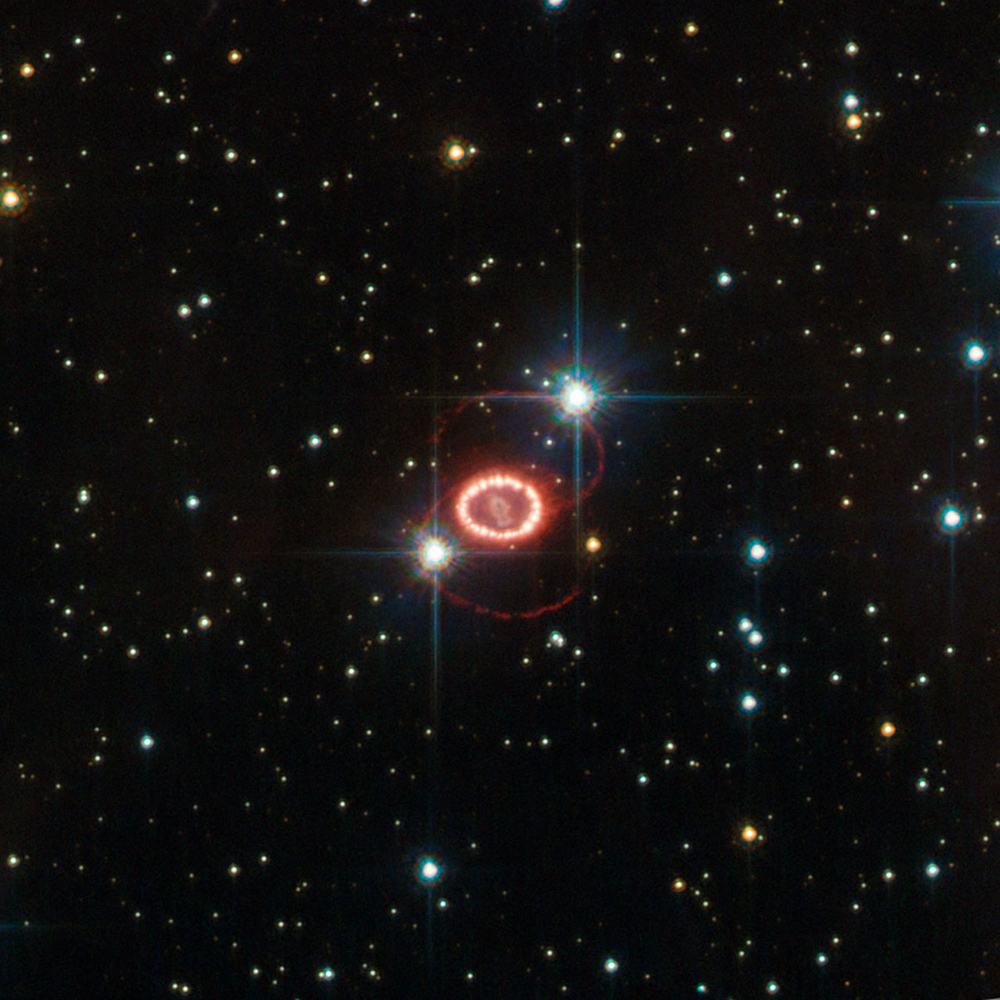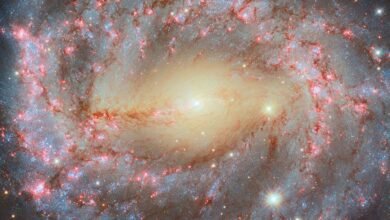Black hole or neutron star? Gravitational wave ‘chirps’ can tell us what becomes of dying stars

New research suggests that this current generation of gravitational wave detectors could “hear” the most energetic core-collapse supernovas at distances thousands of times greater than currently possible, as far as 65 million light-years away, beyond the Milky Way and as distant as the Virgo cluster. If possible, this could help scientists determine if the massive dying star that launches the detected supernova leaves a black hole or a neutron star in its wake.
Since the first detection of tiny ripples in spacetime called “gravitational waves” from collisions and mergers of black holes and neutron stars, the U.S.-based Laser Interferometer Gravitational-Wave Observatory (LIGO), Italy’s Virgo and Japan’s Kamioka Gravitational Wave Detector (KAGRA) have opened up an entirely new window on the cosmos and have created a powerful new form of astronomy that allows scientists to “hear” some of the cosmos’ most violent events.
It is predicted that this current generation of gravitational wave detectors, which collectively form the LIGO-Virgo-Kagra (LVK) collaboration, should be able to detect gravitational waves from the supernova explosions that mark the death of massive stars and the birth of either a black hole or a neutron star, albeit only within the limits of the Milky Way. Yet, thus far, they have failed to hear the high-pitched chirping of supernovas within our galaxy.
Why do scientists expect supernovas to communicate with the cosmos via gravitational waves all, though?
Einstein’s theory of gravity, 1915’s general relativity, suggests that accelerating objects create gravitational waves. That means that when black holes and neutron stars spiral around each other, they emit low-frequency gravitational waves, then produce a high-pitched “chirp” of these spacetime ripples when they collide and merge, usually creating a more massive black hole “daughter.”
Supernovas caused by the accelerating collapse of a star’s core should also produce a gravitational wave chirp, but unlike the call of mergers between dense stellar remnants like black holes and neutron stars, this cosmic chirping hasn’t been “heard” yet.
“Considering the current capabilities of the LVK observatories and our results, we estimate that, under optimal conditions, we could detect up to about one event per year,” team member Maurice van Putten, an astrophysicist from Sejong University, said in a statement. “More conservatively and perhaps more realistically, assuming less favorable conditions and taking into account the limited activity cycles of the detectors, we estimate a detection rate of a few events per decade.
“This is still significantly higher than the two events per century expected in the Milky Way.”
Related: ‘Vampire stars’ explode after eating too much — AI could help reveal why
Black hole or neutron star?
Core collapse supernovas happen when a massive star, at least eight times the mass of the sun, runs out of the fuel for nuclear fusion in its core. This ends the outward pressure of radiation that has supported the star against its own gravity for millions or even billions of years.
As the core crushes down rapidly, shockwaves ripple outward and hit the star’s outer layers. This triggers a supernova explosion that causes the majority of the star’s mass to be blown away. As the stellar core crushes down further, it either becomes a neutron star or a black hole, depending on the mass it has left after this matter is explosively expelled, the shed material surrounds it as a halo of material called a torus.
The team focused on a particular type of core-collapse supernova, Type-1c supernova. This occurs when a massive star explodes after it has lost its outer envelope of hydrogen and helium. The animation below shows the Type-1c core-collapse supernova process.
A subclass of these supernovas is notable because of how rapidly the shell of exploded material they launch spreads away, with these blasts associated with high-energy flashes of radiation called long-duration gamma-ray bursts (GRBs).
The end result of this subclass of core-collapse supernovas is likely to be a rapidly spinning black hole surrounded by a “reservoir of energy” in the form of angular momentum. The amount of angular momentum possessed by these black holes is vastly greater than that of a neutron star created in the same process.
The authors considered a rapidly rotating black hole surrounded by a dense torus of matter that acts as a middleman in the conversion of angular momentum or “spin” into gravitational radiation, or, in other words, gravitational waves.
As the torus cools, it expands away from the stellar remnant at its heart, and the black hole also loses angular momentum and starts to spin slower. This would be colloquially called “deacceleration,” but scientists consider decceleration to be negative acceleration. That means this spin-down should create a negative gravitational wave chirp.

Gravitational wave astronomy hears something standard astronomy can’t see
Spin loss of a black hole has been detected as a chirp in gravitational waves before.
The gravitational wave signal GW 170817 came from the merger of two neutron stars located about 140 million light-years away in the elliptical galaxy NGC 4993. It was followed by a gravitational wave “chirp” designated GW 170817B, which represented the “spin down” of the daughter black hole created by the merger. A similar chirp would be expected in the aftermath of a core-collapse supernova that leaves a rapidly spinning black hole in its wake.
GW 170817B was detected in 2017 during observing run 2 (O2) of the LVK detectors. During the current run (O4), these detectors are almost twice as sensitive as they were. Additionally, the black hole created in such an event would be more massive than that involved with GW 170817B, creating an easier-to-detect signal. The team calculated that the spin-down of a black hole after a core-collapse supernova with a rapidly expanding torus of material would have a higher energy output, bringing it right into the “sweet spot” for detection by the LVK detectors.
These factors led the researchers to conclude that the horizon for detecting such a spin-down chirp should be expanded by around a thousand times. This wider net vastly improves the chances of spotting such a signal.
Such a signal could tell us something about core-collapse supernovas that “traditional astronomy” that relies on electromagnetic radiation can’t. It could tell us the nature of the stellar remnant created in the supernova, namely, whether it is a black hole or neutron star.

To illustrate how useful this could be, consider the supernova remnant SN 1987A. This is one of the brightest stellar explosions visible in the sky, it is located right “next door” to the Milky Way in the Large Magellanic Cloud, a nearby dwarf galaxy about 168,000 light-years away, and it has been extensively studied by astronomers since its discovery 37 years ago. Yet, it was only this year, using the James Webb Space Telescope (JWST), that astronomers were able to determine it is a neutron star that looks at the heart of SN 1987A using electromagnetic observations.
A descending gravitational wave chirp would unambiguously identify a supernova-buried stellar remnant as a black hole, as this is the only cosmic beast capable of chirping like this; neutron stars don’t have enough energy to lose to create such a signal. Alternatively, while a non-detection wouldn’t prove a stellar remnant is a neutron star, it would provide some evidence to support further investigation.
“Our study indicates that the current generation of LVKs may reveal that some supernovae may, in fact, be brighter in their gravitational wave emission than previously believed,” van Putten concluded. “This puts gravitational wave astronomy at the forefront even in fields such as core-collapse supernovas, traditionally the hunting ground of ‘electromagnetic’ astronomers.”
The team’s research was published in The Astrophysical Journal Letters.
Source link



